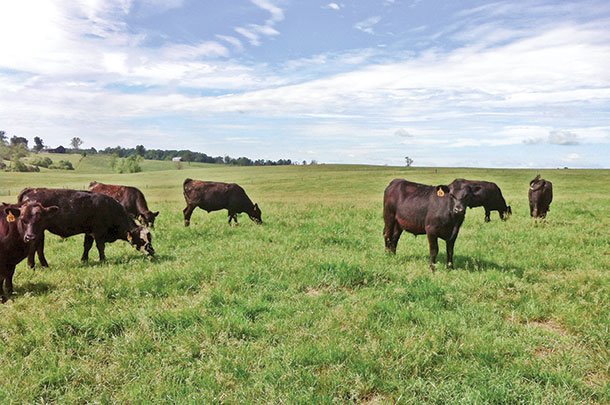But let’s face it: It’s a hassle, and an expensive one, engaging in extensive tillage or spray-smother-spray to convert toxic fescue to a different forage base. What if that’s not in your plan for the near term? What options do you have to make the best of your forage situation?
Know your fescue issue
Let’s start by understanding what we have to work with and why it’s even a problem. Tall fescue (E+), a perennial grass, is widely used as livestock forage in the Southeast and favored for its ability to persist in a variety of management scenarios as well as for its productivity, producing from 2,000 to 3,000 pounds of forage dry matter per acre in the fall when properly managed.
Sounds like a winner, right? Unfortunately, tall fescue, which was introduced to the U.S. in the 1940s, has a major drawback. The very thing that makes fescue so hardy and tough makes it toxic to livestock.
In the late 1970s, researchers in Georgia found fescue hosts an endophyte (fungus) that can produce toxic compounds called ergovaline, responsible for livestock disorders such as fescue foot, bovine fat necrosis and fescue toxicity.
Fescue toxicity is estimated to cost the livestock industry $1 billion annually and manifests in several ways, including rough hair coat; decreased gain; elevated body temperature, which consequently increases respiration rate, time spent in water and shade, and thereby less time spent grazing; reduced feed intake; low blood serum prolactin levels and decreased reproductive performance.

In cow-calf operations, cows grazing infected tall fescue lose body condition and have lower pregnancy rates. Nursing calves have slower gains and reduced weaning weights compared to calves on non-toxic fescue pastures.
Milk production is dramatically decreased by as much as 45 percent in beef cows grazing toxic fescue pastures. The endophyte lives within the plant, and laboratory testing is required to detect it.
An option to consider is eliminating the fescue in enough pastures to graze your cattle in the summer months to avoid the summer slump associated with increasing ergovaline. The recommended spray-smother-spray method of spraying the fescue in the spring, planting a smother crop in the summer and spraying the fescue when it comes back in the fall isn’t a quick fix.
Be conservative when using this approach and don’t kill your entire forage base, just in case there’s a drought which prohibits you from establishing your new forage; you’ll want a fail-safe plan.
Seedhead suppression
One way to minimize the level of ergovaline in the plant is to suppress seedhead production through timely application of select herbicides containing metsulfuron-methyl, since the seedhead is where the majority of ergovaline is found in the plant. Timing of application is three weeks before seedhead emergence or just before boot stage, typically from late March to mid-April, depending on temperature.
In a study by Dr. Glen Aiken, research animal scientist, USDA Agricultural Research Service, seedhead production was 10 times greater in untreated pastures as compared to pastures treated with metsulfuron.
Research conducted by Dr. Jessica Williamson, extension forage crop specialist and assistant professor of plant science, Pennsylvania State University, dovetails with Aiken’s findings. Williamson says, “We found that chemical seedhead suppression in combination with rotational grazing was an exceptional way of not only mitigating fescue toxicosis but also improving animal and pasture performance.”
Overseeding legumes has been shown to dilute the effects of fescue. Research shows animal performance on fescue improves with the inclusion of legumes such as white or red clover and alfalfa.
When establishing legumes into a fescue forage system, start with a soil test to ensure the proper pH and fertility, and get weeds under control; otherwise, you’re wasting your time and money. It is best to plant legumes in early fall before the fescue takes off. Be sure to take full advantage of the legumes and avoid the temptation to apply too much nitrogen.
Speaking of nitrogen, research has shown nitrogen fertilizer contributes to the toxicity of fescue, another advantage of including legumes in this forage system. Dr. John Jennings, professor and extension forage specialist, University of Arkansas Division of Agriculture, says, “Performance is improved somewhat with addition of legumes, but animals will still be affected by fescue toxicity, showing symptoms of higher body temperatures, rough hair coat and other factors. Because of the lower cost of production, the addition of clover increased return per acre on both toxic and novel-endophyte fescue.”
New breeding seasons
Shifting the cow herd from one breeding season to another, however, could be beneficial in terms of animal performance on a fescue-based system. A review of 19 years worth of data from the Research and Education Center in Grand Junction, Tennessee, comparing spring- and fall-calving beef herds grazing tall fescue shows the fall-calving herd increased farm income as it raised a greater number of calves and required fewer replacement heifers.
Heifers in the spring-calving herd averaged 27 days older at calving than the fall-calving heifers, produced fewer calves per cow, but did have a shorter calving interval.
Spring-calving herds on fescue have lower calving rate due to the increased exposure to ergovaline in fescue, which increases during the warmer weather at breeding as compared to the fall-calving herd.
Over the course of the 19-year study, on average, spring-calving cows were in the herd three years, and fall-calving cows were in the herd four years. This longevity in the fall herd accounts for an increase in profitability of the fall herd in contrast to the spring-calving herd.
“Spring-calving beef herds suffer the highest negative impact from fescue toxicity. Calving rates, calf weaning weights and bull fertility decrease due to fescue toxicity during warm weather. Fall-calving herds have near-normal conception rates while grazing E+ fescue, which indicates the lower impact of fescue toxicity on breeding in cooler weather.”
Jennings says, “Recent research shows that toxic fescue reduces reproduction rates of spring-calving herds much more than fall-calving herds. At the Livestock and Forestry Branch Station near Batesville, Arkansas, spring-calving herds had calving rates (63-day breeding season) of only 44 percent when grazing toxic fescue year-round.
Converting 25 percent of the pasture to NE fescue improved spring calving rates to 80 percent. Fall-calving herds maintained calving rates of over 92 percent whether on toxic E+ fescue year-round or if 25 percent of the pasture was converted to NE+ fescue.”
Fescue toxicity affects bulls as well. Jennings says, “Graze bulls on non-toxic forage starting 60 days before breeding season. The negative effects of E+ fescue on spermatogenesis can begin 60 days prior to breeding. As temperatures increase in summer, negative effects increase. Avoid late-summer breeding and provide non-toxic forage for as much of the breeding season as possible.”
Conventional wisdom has been that supplementation can reduce the effect of ergovaline in fescue. Research has shown that might not be exactly right, Dr. Shane Gadberry, associate professor, University of Arkansas Department of Animal Science, says. “Supplementation is likely not reducing the effects of toxins as much as it is compensating for a lower forage intake, which is a response to fescue toxins, or lower nutrient composition of fescue hay due to harvesting in a mature stage of growth.”
As cattle producers, you have options in managing fescue toxicity; the task of choosing the best fit for your operation falls to you. ![]()
PHOTO 1: One way to minimize the level of ergovaline in the plant is to suppress seedhead production.
PHOTO 2: Research shows toxic fescue reduces reproduction rates of spring-calving herds more than fall-calving herds. Photos by Dr. Jessica Williamson.

-
Melissa Beck
- Freelance Writer
- Prescott, Arkansas
- Email Melissa Beck







